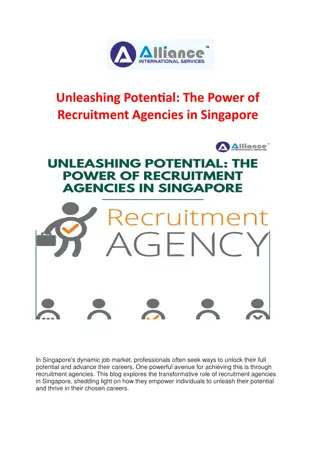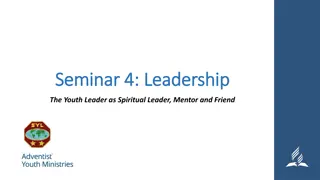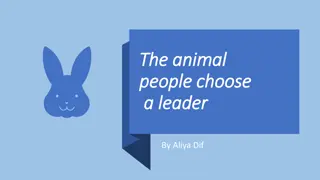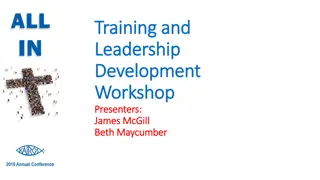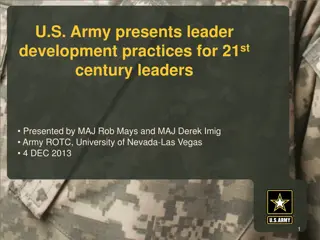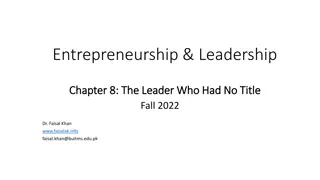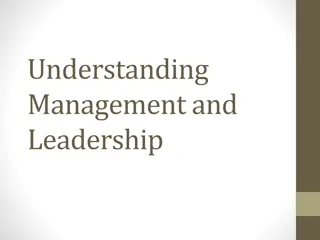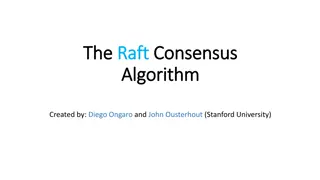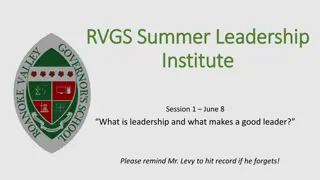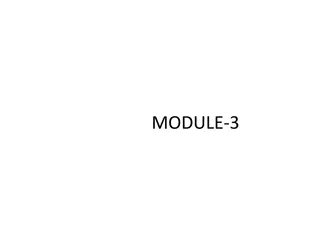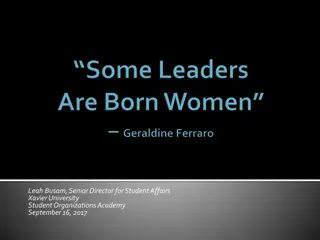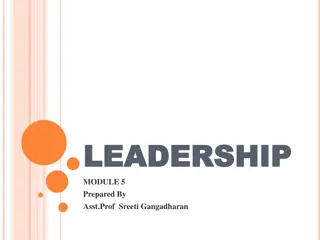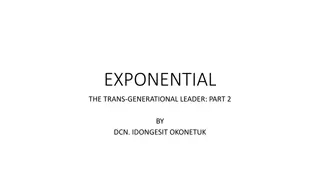Unleashing Leadership Potential: A Guide to Becoming a Powerful Leader
Understanding the essence of leadership, this guide explores the definition of a leader, their role, various leadership styles, and the traits of effective leaders. It delves into self-assessment, discussing what it takes to excel as a leader and providing insights into leadership in business contexts and entrepreneurship. The concept of leadership in motivating others towards a shared vision is highlighted, emphasizing the importance of inspiration and guidance in achieving desired outcomes.
Download Presentation

Please find below an Image/Link to download the presentation.
The content on the website is provided AS IS for your information and personal use only. It may not be sold, licensed, or shared on other websites without obtaining consent from the author. Download presentation by click this link. If you encounter any issues during the download, it is possible that the publisher has removed the file from their server.
E N D
Presentation Transcript
Overview 1. 2. 3. 4. 5. 6. 7. 8. 9. Definition of the notions: leader and leadership What exactly do leaders do? Types of leaders Leadership styles Building the leader's authority Personality traits of an effective leader Exercise: We evaluate our own leadership abilities Discussion: What kind of a leader am I and what else do I have to learn? References
Leader how do you understand this notion? In your opinion How do you understand the meaning of the word leader in general use? Think of the senses in your native language and in English. Are they similar? How do you understand the meaning of the word leader in the business context? Additional questions: Can you list two to five people who act as leaders? Does being a leader require specific character traits? Do you have to be born a leader? What makes someone a successful leader?
Leader how do you understand this notion? Additional task: Compare the meanings of the word leader in Merriam-Webster Dictionary: https://www.merriam-webster.com/dictionary/leader and in a dictionary of your native language.
Leader how do you understand this notion? In your opinion How do you understand the meaning of the word leader in the context of entrepreneurship (in a company, or organization)? Is being a leader in a company or organization any different from being a leader in private life? What are the tasks facing a leader in business conditions? How do you understand the notion of leadership? Will the type of these tasks determine the style of leadership?
A leader and leadership in the context of entrepreneurship Leaders get things done through people. They set the direction and get other people to follow them. As Ted Johns (2008) says: A leader takes people where they want to go. A great leader takes people where they don t necessarily want to be, but ought to be. (Amstrong Michael, 2000, p. 30). To lead is to inspire, influence and guide. Leadership is the process of getting people to do their best to achieve a desired result. It involves developing and communicating a vision for the future, motivating people and gaining their engagement. (Amstrong Michael, 2000, p. 4).
What exactly do leaders do? According to Amstrong (2000, p. 33), leaders have three essential roles. 1. Defining the task they must make it clear what the group is expected to do. 2. Achieving the task they ensure that the group s purpose is fulfilled. 3. Maintaining effective relationships between themselves and the members of the group, and between the people within the group. These relationships are effective if they contribute to achieving the task.
Types of leaders Transactional leaders: identify the expectations of their followers and respond to them by establishing a close link between effort and reward (a transaction). Transformational leaders: empower their followers and encourage them to do more than they originally expected to do . Charismatic leaders: they have compelling personalities and the ability to rouse people to follow them through the sheer force of the impression they make. They are achievement orientated, calculated risk-takers and good communicators.
Types of leaders Situational leaders: they can adopt different leadership styles depending on the situation. The behaviour of leaders towards their followers can take the following forms: Directing leaders define the roles and tasks of their followers and supervise them closely. Decisions are made and announced by the leader, so communication is largely one-way. Delegating leaders are still involved in decisions and problem-solving, but control is with the follower. The follower decides when and how the leader will be involved. Coaching leaders still define roles and tasks but seek ideas and suggestions from the followers. Decisions remain the leader s prerogative, but communication is much more two-way. Supporting leaders pass day-to-day decisions, such as task allocation and processes, to followers. Leaders facilitate and take part in decisions, but control is with the follower.
Leadership styles Leaders adopt different leadership styles. To varying degrees leaders can be achievement-orientated, task-orientated or people-orientated. They can be: Charismatic/non-charismatic Autocratic/democratic Enabler/controller Transactional/transformational What do you think these leadership styles involve?
Types of leaders Remember: There is no perfect leadership style. Extremes are wrong. Effective leaders are able to move between the styles according to the situation. The style depends on the type of organization, the nature of the task, characteristics of team members and the group as a whole, the personality of the leader, culture in which the organization operates (e.g., Polish, Czech, Slovak, Hunagrian, German, Japanese). Likewise, there is no such thing as an ideal leadership style. What influences an approach adopted by a leader is the given situation and context in which a leader and their teams function. .
Building the leader's authority The leader's authority should be based on mutual respect and respect for the personal rights of employees and their own. The leader builds his authority based on 4 pillars: Knowledge Skills Experience (age) Competences in building relationships with the team (communication and assertive competence).
Building the leaders authority In your opinion: What role does body language play in building a leader's authority?
Body language in building the leader's authority Eye contact (for the first 5 seconds of the conversation, then 70% of the conversation time) Smile (sincere but not very expressive) A firm and self-confident voice tempo Appropriate body posture (upright body, not sitting on the edge) Appropriate dress Appropriate look of the workplace Emotional stability.
Personality traits of an effective leader 1. 2. They are confident about their job and know what to do. They have a vision and are able to convey the vision by means of appropriate behaviour in fornt of the team. They are trustworthy and effectively influence the team. They appreciate the possibility of consulting the team. They build a well-coordinated team, but they can set boundaries (they areassertive). 3. 4. 5.
Personality traits of an effective leader 6. They give the team directions for the development of its members. 7. They treat the team with respect. 8. They are flexible - they can switch between leadership styles. 9. They can express their opinions and give the team feedback. 10. They carefully observe themselves and know how to improve their skills. 11. They do not take the tasks out of the team members, but can act as the performer of the task if necessary.
We evaluate our own leadership abilities It is time to fill in the worksheet! Good luck!
Discussion In your opinion: What kind of a leader am I and what else do I have to learn?
References 1. Amstrong M., 2000, How to Manage People: Fast, Effective Management Skills That Really Get Results. London and Philadelphia. 2. Amstrong M., 2005, Armstrong's Handbook of Management and Leadership. A guide to managing for results. 2nd edition. London and Philadelphia. 3. Adair J., 1973, The Action Centred Leader. London. Photos: Microsoft 365.



